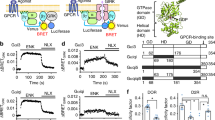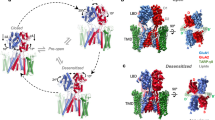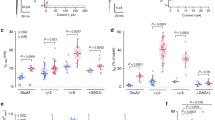Abstract
Transmembrane signal transduction via heterotrimeric G proteins is reported to be inhibited by RGS (regulators of G-protein signalling) proteins1,2,3,4. These RGS proteins work by increasing the GTPase activity of G protein α-subunits (Gα), thereby driving G proteins into their inactive GDP-bound form5,6,7. However, it is not known how RGS proteins regulate the kinetics of physiological responses that depend on G proteins. Here we report the isolation of a full-length complementary DNA encoding a neural-tissue-specific RGS protein, RGS8, and the determination of its function. We show that RGS8 binds preferentially to the α-subunits Gαo and Gαi3 and that it functions as a GTPase-activating protein (GAP). When co-expressed in Xenopus oocytes with a G-protein-coupled receptor and a G-protein-coupled inwardly rectifying K+channel (GIRK1/2), RGS8 accelerated not only the turning off but also the turning on of the GIRK1/2 current upon receptor stimulation, without affecting the dose–response relationship. We conclude that RGS8 accelerates the modulation of G-protein-coupled channels and is not just a simple negative regulator. This property of RGS8 may be crucial for the rapid regulation of neuronal excitability upon stimulation of G-protein-coupled receptors.
This is a preview of subscription content, access via your institution
Access options
Subscribe to this journal
Receive 51 print issues and online access
$199.00 per year
only $3.90 per issue
Buy this article
- Purchase on Springer Link
- Instant access to full article PDF
Prices may be subject to local taxes which are calculated during checkout




Similar content being viewed by others
References
Koelle, M. R. A new family of G-protein regulators—the RGS protein. Curr. Opin. Cell Biol. 9, 143–147 (1997).
Dohlman, H., Apaniesk, D., Chen, Y., Song, J. & Dlusskem, D. Inhibition of G-protein signaling by dominant gain-of-function mutation in Sst2p, a pheromone desensitization factor in Saccharomyces cerevisiae. Mol. Cell Biol. 15, 3635–3643 (1995).
Koelle, M. R. & Horvitz, H. R. EGL-10 regulates G protein signaling in the C. elegans nervous system and shares a conserved domain with many mammalian proteins. Cell 84, 115–125 (1996).
Druey, K. M., Blumer, K. J., Kang, V. H. & Kehrl, J. H. Inhibition of G-protein-mediated MAP kinase activation by a new mammalian gene family. Nature 379, 742–746 (1996).
Berman, D. M., Wilkie, T. M. & Gilman, A. G. GAlP and RGS4 are GTPase-activating proteins for the Gi subfamily of G protein α subunits. Cell 86, 445–452 (1996).
Watson, N., Linder, M. E., Druey, K. M., Kehrl, J. H. & Blumer, K. J. RGS family members: GTPase-activating proteins for heterotrimeric G-protein α-subunits. Nature 383, 172–175 (1996).
Hunt, T. W., Fields, T. A., Casey, P. J. & Peralta, E. G. RGS10 is a selective activator of Gαi GTPase activity. Nature 383, 175–177 (1996).
Jones-Villeneuve, E. M. V., McBurney, M. W., Rogers, K. A. & Kalnins, V. I. Retinoic acid induces embryonal carcinoma cells to differentiate into neurons and glial cells. J. Cell Biol. 94, 253–262 (1982).
Chen, C.-K., Wieland, T. & Simon, M. I. RGS-r, a retinal specific RGS protein, binds an intermediate conformation of transducin and enhances recycling. Proc. Natl Acad. Sci. USA 93, 12885–12889 (1996).
Siderovski, D. P., Heximer, S. P. & Forsdyke, D. R. Ahuman gene encoding a putative basic helix-loop-helix phosphorprotein whose mRNA increases rapidly in cycloheximide-treated blood mononuclear cells. DNA Cell Biol. 13, 125–147 (1994).
Reuveny, E. et al. Activation of the cloned muscarinic potassium channel by G protein βγ subunits. Nature 370, 143–146 (1994).
Wickman, K. & Clapham, D. E. Ion channel regulation by G proteins. Physiol. Rev. 75, 865–885 (1995).
Werner, P., Hussy, N., Buell, G., Jones, K. A. & North, R. A. D2, D3, and D4 dopamine receptors coupled to G protein-regulated potassium channels in Xenopus oocytes. Mol. Pharmacol. 49, 656–661 (1996).
Saugstad, J. A., Segerson, T. P. & Westbrook, G. L. Metabotropic glutamate receptors activate G-protein-coupled inwardly rectifying potassium channels in Xenopus oocytes. J. Neurosci. 16, 5979–5985 (1996).
Sodickson, D. L. & Bean, B. P. GABABreceptor-activated inwardly rectifying potassium current in dissociated hippocampal CA3 neurons. J. Neurosci. 15, 6374–6385 (1996).
Lesage, F. et al. Cloning provides evidence for a family of inward rectifier and G-protein coupled K + channels in the brain. FEBS Lett. 353, 37–42 (1994).
Breitwieser, G. E. & Szabo, G. Mechanism of muscarinic receptor-induced K+ channel activation as revealed by hydrolysis-resistant GTP analogues. J. Gen. Physiol. 91, 469–493 (1988).
Shui, Z., Boyett, M. R., Zang, W. J., Haga, T. & Kameyama, K. Receptor kinase-dependent desensitization of the muscarinic K+ current in rat atrial cells. J. Physiol. (Lond.) 487, 359–366 (1995).
Kubo, Y., Reuveny, E., Slesinger, P. A., Jan, Y. N. & Jan, L. Y. Primary structure and functional expression of a rat G-protein-coupled muscarinic potassium channel. Nature 364, 802–806 (1993).
Lesage, F. et al. Molecular properties of neuronal G-protein-activated inwardly rectifying K+ channels. J. Biol. Chem. 270, 28660–28667 (1995).
Velimirovic, B. M., Gordon, E. A., Lim, N. F., Navarro, B. & Clapham, D. E. The K+ channel inward rectifier subunits form a channel similar to neuronal G protein-gated K+ channel. FEBS Lett. 379, 31–37 (1996).
Krapivinsky, G. et al. The G-protein-gated atrial K+ channel IKAChis a heteromultimer of two inwardly rectifying K+-channel proteins. Nature 374, 135–141 (1995).
Asano, T., Kamiya, N., Morishita, R. & Kato, K. Immunoassay for the βγ subunits of GTP-binding proteins and their regional distribution in bovine brain. J. Biochem. 103, 950–953 (1988).
Abe, H., Saitoh, O., Nakata, H., Yoda, A. & Matsuda, R. Expression of neurofilament proteins in proliferating C2C12 mouse skeletal muscle cells. Exp. Cell Res. 229, 48–59 (1996).
Acknowledgements
We thank M. Lazdunski for GIRK2 cDNA, A. Connolly for m2 muscarinic receptor and D2 dopamine receptor cDNA, K. Yamagata for the cDNA library, M. Odagiri for technical assistance. This work is supported by research grants from the Ministry of Education, Science, Sports and Culture of Japan (to O.S.) and from the Human Frontier Science Program Organization (to Y.K.) and by a grant-in-aid for scientific research on priority area of “channel-Transporter Correlation” (to Y.K.).
Author information
Authors and Affiliations
Corresponding authors
Rights and permissions
About this article
Cite this article
Saitoh, O., Kubo, Y., Miyatani, Y. et al. RGS8 accelerates G-protein-mediated modulation of K+currents. Nature 390, 525–529 (1997). https://doi.org/10.1038/37385
Received:
Accepted:
Issue Date:
DOI: https://doi.org/10.1038/37385
This article is cited by
-
Circadian regulation of intracellular G-protein signalling mediates intercellular synchrony and rhythmicity in the suprachiasmatic nucleus
Nature Communications (2011)
-
Rgs8
AfCS-Nature Molecule Pages (2010)
-
Endogenous RGS proteins enhance acute desensitization of GABAB receptor-activated GIRK currents in HEK-293T cells
Pfl�gers Archiv - European Journal of Physiology (2005)
-
G-protein signaling: back to the future
Cellular and Molecular Life Sciences (2005)
-
Regulators of G-Protein signalling as new central nervous system drug targets
Nature Reviews Drug Discovery (2002)
Comments
By submitting a comment you agree to abide by our Terms and Community Guidelines. If you find something abusive or that does not comply with our terms or guidelines please flag it as inappropriate.



